Effect of Yttrium Oxide on Microstructure and Oxidation Behavior of Cr/FeCrAl Coatings Fabricated by Extreme High-Speed Laser Cladding Process: An Experimental Approach
Abstract
:1. Introduction
2. Experimental Approaches
2.1. Materials
2.2. Coating Preparation
2.3. Oxidation Tests
2.4. Microstructure and Composition Characterization
3. Results and Discussion
3.1. Microstructure of the Cladding Coatings
3.2. Oxidation Behavior
3.3. Phase Evolution
3.4. Microstructure of the Coatings After Oxidation
3.5. High-Temperature Steam Oxidation Mechanism
4. Conclusions
Supplementary Materials
Author Contributions
Funding
Institutional Review Board Statement
Informed Consent Statement
Data Availability Statement
Conflicts of Interest
References
- Zinkle, S.J.; Was, G.S. Materials Challenges in Nuclear Energy. Acta Mater. 2013, 61, 735–758. [Google Scholar] [CrossRef]
- Yang, J.; Steinbrück, M.; Tang, C.; Große, M.; Liu, J.; Zhang, J.; Yun, D.; Wang, S. Review on Chromium Coated Zirconium Alloy Accident Tolerant Fuel Cladding. J. Alloys Compd. 2022, 895, 162450. [Google Scholar] [CrossRef]
- Kim, H.-G.; Kim, I.-H.; Jung, Y.-I.; Park, D.-J.; Park, J.-H.; Choi, B.-K.; Lee, Y.-H. Out-of-Pile Performance of Surface-Modified Zr Cladding for Accident Tolerant Fuel in LWRs. J. Nucl. Mater. 2018, 510, 93–99. [Google Scholar] [CrossRef]
- Terrani, K.A.; Parish, C.M.; Shin, D.; Pint, B.A. Protection of Zirconium by Alumina- and Chromia-Forming Iron Alloys under High-Temperature Steam Exposure. J. Nucl. Mater. 2013, 438, 64–71. [Google Scholar] [CrossRef]
- Zhong, W.; Mouche, P.A.; Heuser, B.J. Response of Cr and Cr-Al Coatings on Zircaloy-2 to High Temperature Steam. J. Nucl. Mater. 2018, 498, 137–148. [Google Scholar] [CrossRef]
- Park, D.J.; Kim, H.G.; Park, J.Y.; Jung, Y.I.; Park, J.H.; Koo, Y.H. A Study of the Oxidation of FeCrAl Alloy in Pressurized Water and High-Temperature Steam Environment. Corros. Sci. 2015, 94, 459–465. [Google Scholar] [CrossRef]
- Pint, B.A.; Terrani, K.A.; Brady, M.P.; Cheng, T.; Keiser, J.R. High Temperature Oxidation of Fuel Cladding Candidate Materials in Steam–Hydrogen Environments. J. Nucl. Mater. 2013, 440, 420–427. [Google Scholar] [CrossRef]
- He, L.; Liu, C.; Lin, J.; Chen, Q.; Yang, J.; Zhang, R.; Yang, H.; Wang, Y.; Wang, J.; Long, J.; et al. Microstructure, Oxidation and Corrosion Properties of FeCrAl Coatings with Low Al Content Prepared by Magnetron Sputtering for Accident Tolerant Fuel Cladding. J. Nucl. Mater. 2021, 551, 152966. [Google Scholar] [CrossRef]
- Wang, Y.; Zhou, W.; Wen, Q.; Ruan, X.; Luo, F.; Bai, G.; Qing, Y.; Zhu, D.; Huang, Z.; Zhang, Y.; et al. Behavior of Plasma Sprayed Cr Coatings and FeCrAl Coatings on Zr Fuel Cladding under Loss-of-Coolant Accident Conditions. Surf. Coat. Technol. 2018, 344, 141–148. [Google Scholar] [CrossRef]
- Dabney, T.; Johnson, G.; Yeom, H.; Maier, B.; Walters, J.; Sridharan, K. Experimental Evaluation of Cold Spray FeCrAl Alloys Coated Zirconium-Alloy for Potential Accident Tolerant Fuel Cladding. Nucl. Mater. Energy 2019, 21, 100715. [Google Scholar] [CrossRef]
- Xiao, Y.; Xiao, H.; Mo, T.; Ren, L.; Tian, Y.; Zhu, L. High-Temperature and Interfacial Oxidation of MAX Phase-Reinforced Composite Coatings Deposited by Laser Cladding on Zr Alloy Substrates. Ceram. Int. 2023, 49, 38672–38682. [Google Scholar] [CrossRef]
- Liang, Y.; Liao, Z.Y.; Zhang, L.L.; Cai, M.W.; Wei, X.S.; Shen, J. A Review on Coatings Deposited by Extreme High-Speed Laser Cladding: Processes, Materials, and Properties. Opt. Laser Technol. 2023, 164, 109472. [Google Scholar] [CrossRef]
- Maolin, L.; Lanfang, G.; Liangquan, G.; Guoqiang, Z.; Chunhai, L. Microstructure Evolution of FeCrAl Coating with Low Al Content Under High-Temperature Air Oxidation. Rare Met. Mater. Eng. 2023, 52, 3691–3696. (In Chinese) [Google Scholar]
- Yang, X.; Luan, B.; Chen, L.; Wu, J.; Zhu, P.; Zhou, H.; Ruan, H.; Huang, W.; Sun, C.; Qiu, S. Improved Oxidation Resistance of Cr/FeCrAl Coating on Zr Alloy in High-Temperature Steam Environment. Surf. Coat. Technol. 2023, 473, 129992. [Google Scholar] [CrossRef]
- Zhu, P.; Ruan, H.; Huang, W.; Zhang, T.; Sun, L.; Ning, Y.; Xu, M.; Liao, H.; Wang, J.; Su, Y. Microstructural Evolution of the Cr/FeCrAl Coated Zircaloy-4 under Simulated PWR and High-Temperature Steam Oxidation Environments. J. Nucl. Mater. 2024, 600, 155266. [Google Scholar] [CrossRef]
- Yan, J.; Gao, Y.; Liang, L.; Ye, Z.; Li, Y.; Chen, W.; Zhang, J. Effect of Yttrium on the Cyclic Oxidation Behaviour of HP40 Heat-Resistant Steel at 1373K. Corros. Sci. 2011, 53, 329–337. [Google Scholar] [CrossRef]
- Weisenburger, A.; Heinzel, A.; Müller, G.; Muscher, H.; Rousanov, A. T91 Cladding Tubes with and without Modified FeCrAlY Coatings Exposed in LBE at Different Flow, Stress and Temperature Conditions. J. Nucl. Mater. 2008, 376, 274–281. [Google Scholar] [CrossRef]
- Hu, Y.; Chen, S.; Huang, J.; Song, M. Marangoni Effect on Pool Boiling Heat Transfer Enhancement of Self-Rewetting Fluid. Int. J. Heat Mass Transf. 2018, 127, 1263–1270. [Google Scholar] [CrossRef]
- Wang, Y.; Tang, H.; Han, X.; Feng, W.; Zhou, X.; Peng, S.; Zhang, H. Oxidation Resistance Improvement of Zr-4 Alloy in 1000 °C Steam Environment Using ZrO2/FeCrAl Bilayer Coating. Surf. Coat. Technol. 2018, 349, 807–815. [Google Scholar] [CrossRef]
- Cheng, X.; Fan, L.; Liu, L.; Du, K.; Wang, D. Effect of Doping Aluminum and Yttrium on High-Temperature Oxidation Behavior of Ni-11Fe-10Cu Alloy. J. Rare Earths 2016, 34, 1139–1147. [Google Scholar] [CrossRef]
- Yang, L.; Li, Z.; Zhang, Y.; Wei, S.; Wang, Y.; Kang, Y. In-Situ TiC-Al3Ti Reinforced Al-Mg Composites with Y2O3 Addition Formed by Laser Cladding on AZ91D. Surf. Coat. Technol. 2020, 383, 125249. [Google Scholar] [CrossRef]
- Zhao, K.; Peng, X.; Xie, W.; Wei, Q.; Yang, Y.; Wei, G. Effects of Ce on Microstructure of Semi-Continuously Cast Mg-1.5Zn-0.2Zr Magnesium Alloy Ingots. Trans. Nonferrous Met. Soc. China 2010, 20, s324–s330. [Google Scholar] [CrossRef]
- Hansen, N. Hall–Petch Relation and Boundary Strengthening. Scr. Mater. 2004, 51, 801–806. [Google Scholar] [CrossRef]
- Leyland, A.; Matthews, A. On the Significance of the H/E Ratio in Wear Control: A Nanocomposite Coating Approach to Optimised Tribological Behaviour. Wear 2000, 246, 1–11. [Google Scholar] [CrossRef]
- Sakharova, N.A.; Fernandes, J.V.; Oliveira, M.C.; Antunes, J.M. Influence of Ductile Interlayers on Mechanical Behaviour of Hard Coatings under Depth-Sensing Indentation: A Numerical Study on TiAlN. J. Mater. Sci. 2010, 45, 3812–3823. [Google Scholar] [CrossRef]
- Li, Z.; Wang, Y.; Cheng, X.; Zeng, Z.; Li, J.; Lu, X.; Wang, L.; Xue, Q. Continuously Growing Ultrathick CrN Coating to Achieve High Load-Bearing Capacity and Good Tribological Property. ACS Appl. Mater. Interfaces 2018, 10, 2965–2975. [Google Scholar] [CrossRef]
- Chen, G.; Yang, H.; Sun, H.; Wang, F.; Wang, H.; Kong, Q.; An, X.; Zhang, Y.; Wang, J. Exploring the High-Temperature Steam Oxidation Behaviors of the Lean-Cr (7–10 Wt.%) FeCrAl Alloys. Corros. Sci. 2022, 194, 109927. [Google Scholar] [CrossRef]
- Yang, F.; Fang, D.-N.; Liu, B. A Theoretical Model and Phase Field Simulation on the Evolution of Interface Roughness in the Oxidation Process. Model. Simul. Mater. Sci. Eng. 2012, 20, 015001. [Google Scholar] [CrossRef]
- Huntz, A.M. Stresses in NiO, Cr2O3, and Al2O3, Oxide Scales. Mater. Sci. Eng. A 1995, 201, 211–228. [Google Scholar]
- Przybylski, K.; Garratt-Reed, A.J.; Yurek, G.J. Grain Boundary Segregation of Yttrium in Chromia Scales. J. Electrochem. Soc. 1988, 135, 509–517. [Google Scholar] [CrossRef]
- Pint, B.A.; Martin, J.R. 18O/SIMS Characterization of the Growth Mechanism of Doped and Undoped α-Al2O3. Oxid. Met. 1993, 39, 167–195. [Google Scholar]
- Meng, Y.; Chen, C.; Zeng, S.; Zhu, C.; Zhou, X.; Han, X. Investigations of Oxidation Behavior and Establishment of Life-Cycle Model during the Steam Oxidation of Cr-Coated Zry-4 at 1200 °C. Corros. Sci. 2024, 226, 111694. [Google Scholar] [CrossRef]
- Cotell, C.M.; Yurek, G.J.; Hussey, R.J.; Mitchell, D.F.; Graham, M.J. The Influence of Implanted Yttrium on the Mechanism of Growth of Cr2O3 on Cr. J. Electrochem. Soc. 1987, 134, 1871–1872. [Google Scholar] [CrossRef]
- Quadakkers, W.J.; Holzbrecher, H.; Briefs, K.G.; Beske, H. Differences in Growth Mechanisms of Oxide Scales Formed on ODS and Conventional Wrought Alloys. Oxid. Met. 1989, 32, 67–88. [Google Scholar] [CrossRef]
- Yurek, G.J.; Przybylski, K.; Garratt-Reed, A.J. Segregation of Y to Grain Boundaries in Cr2O3 and NiO Scales Formed on an ODS Alloy. J. Electrochem. Soc. 1987, 134, 2643–2644. [Google Scholar] [CrossRef]
- Maruoka, D.; Nanko, M. Improved Crack Healing and High-Temperature Oxidation Resistance of Ni/Al2O3 by Y or Si Doping. J. Am. Ceram. Soc. 2016, 99, 2451–2457. [Google Scholar] [CrossRef]
- Bunaciu, A.A.; Udriştioiu, E.G.; Aboul-Enein, H.Y. X-Ray Diffraction: Instrumentation and Applications. Crit. Rev. Anal. Chem. 2015, 45, 289–299. [Google Scholar] [CrossRef]
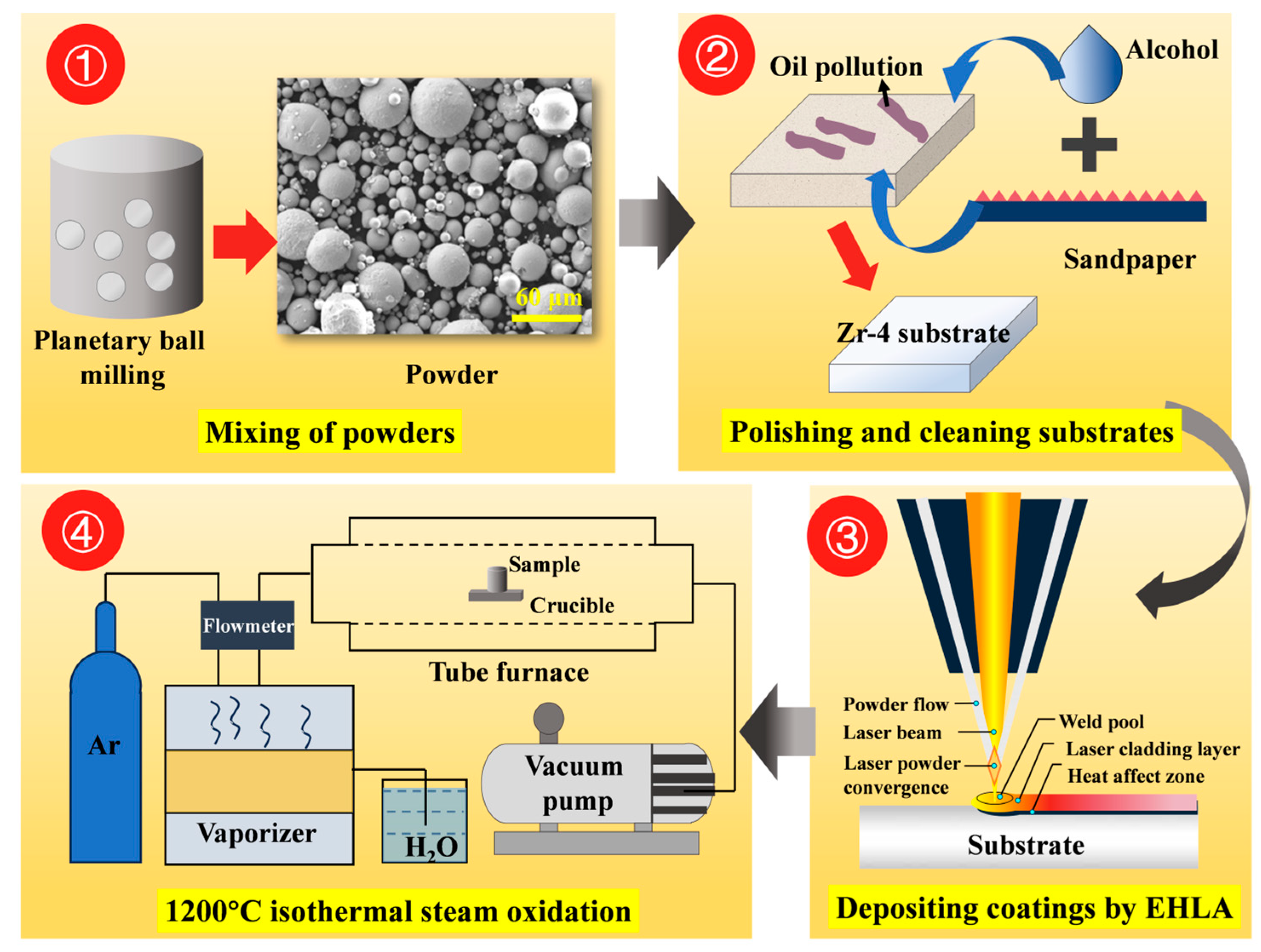
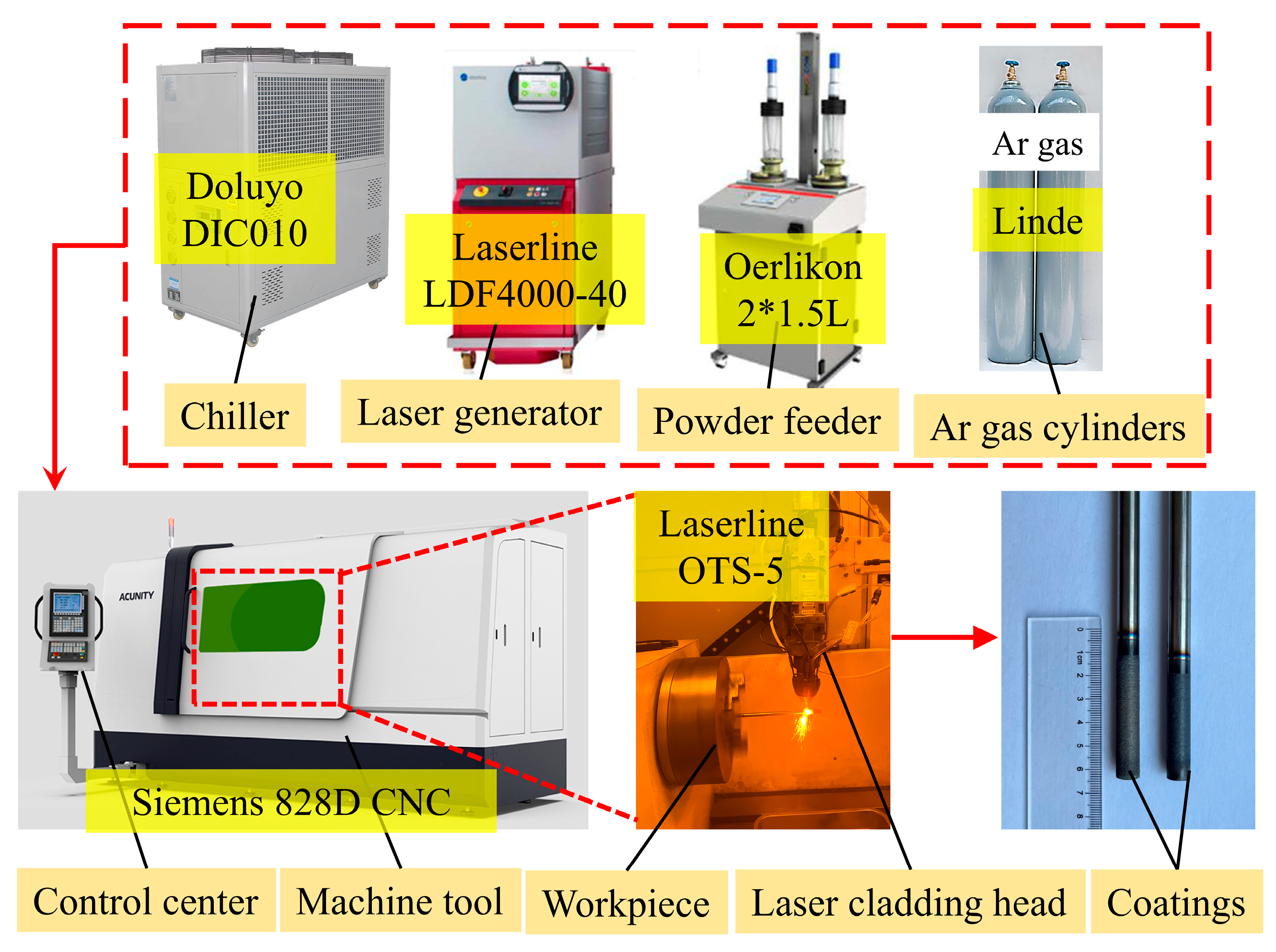
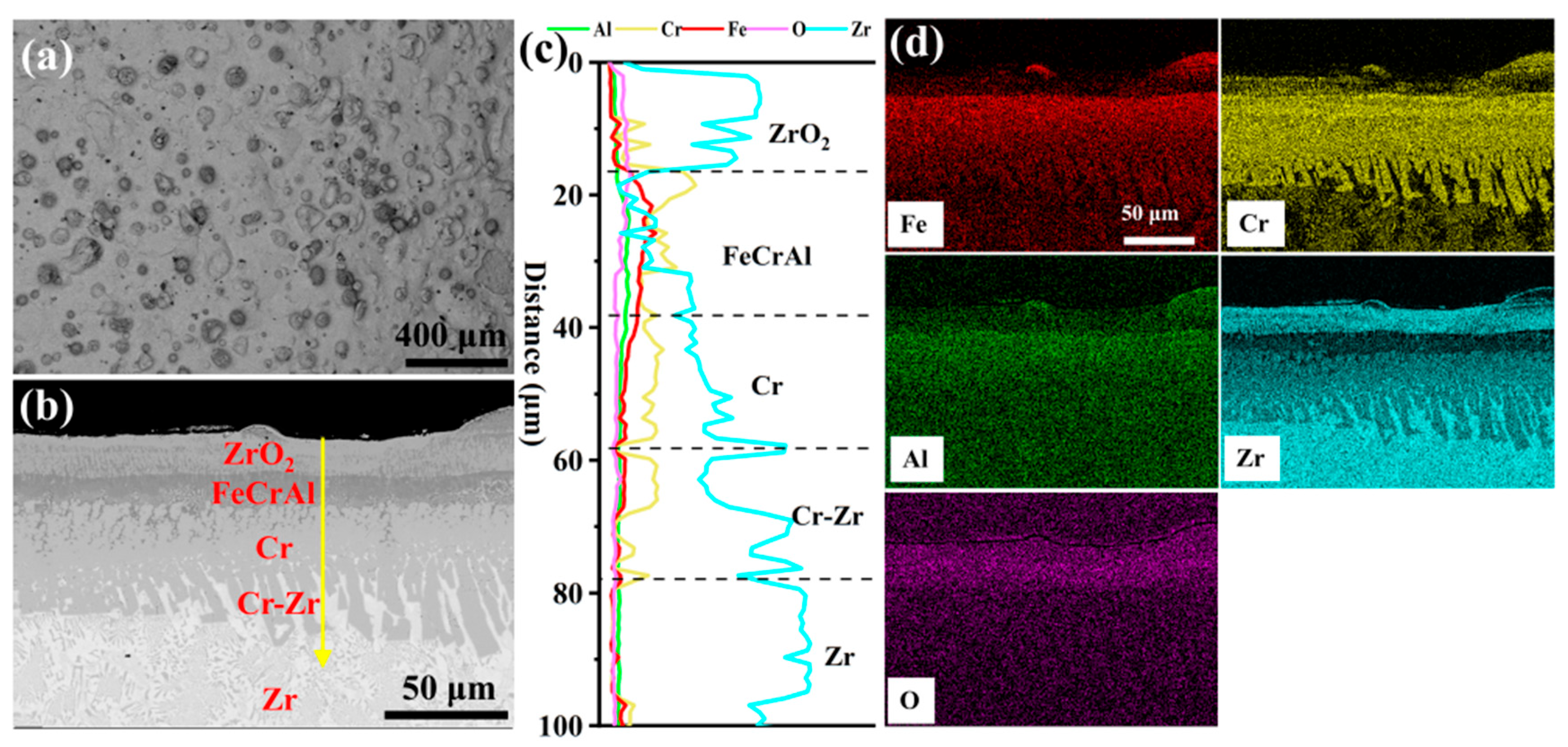
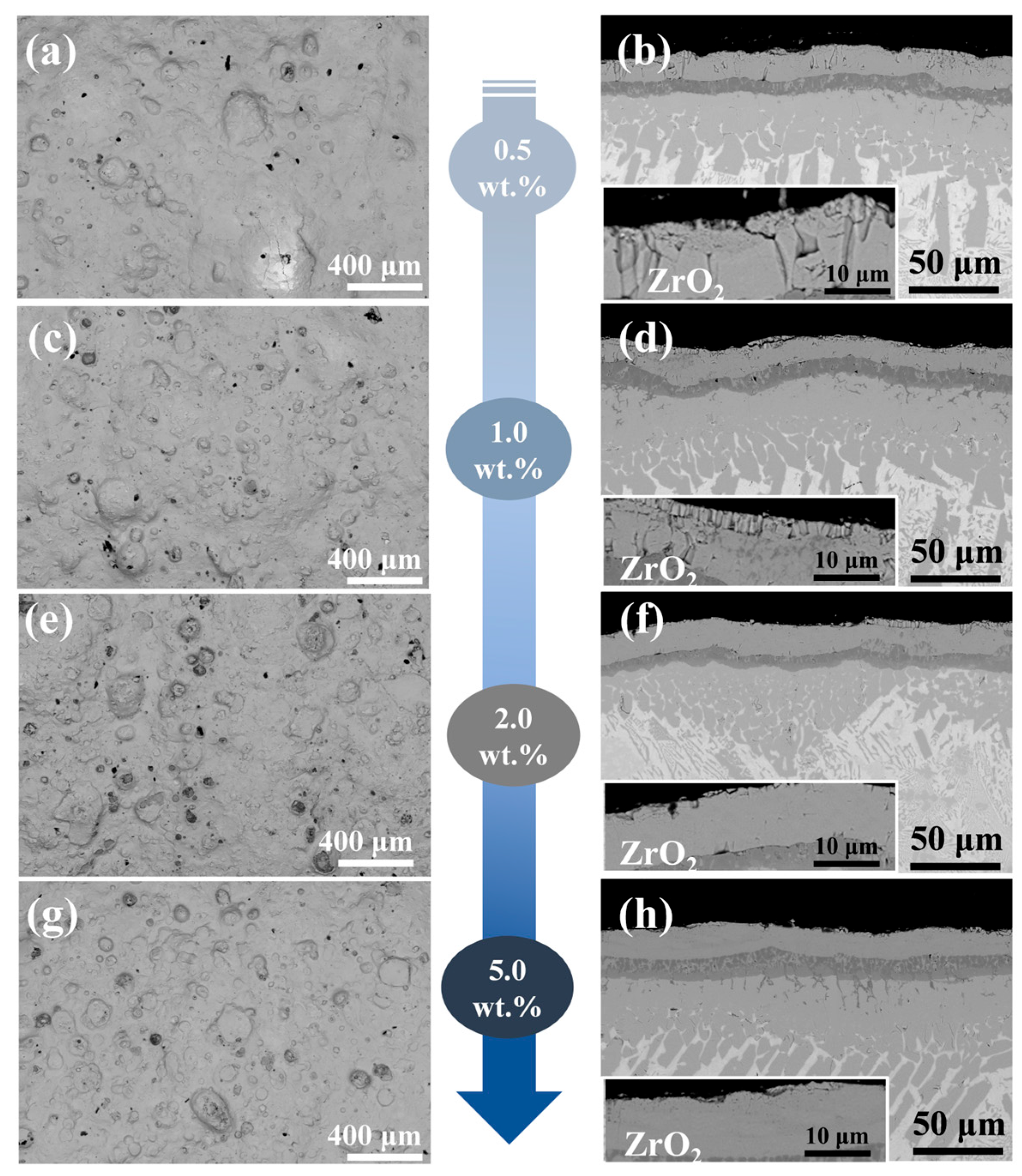
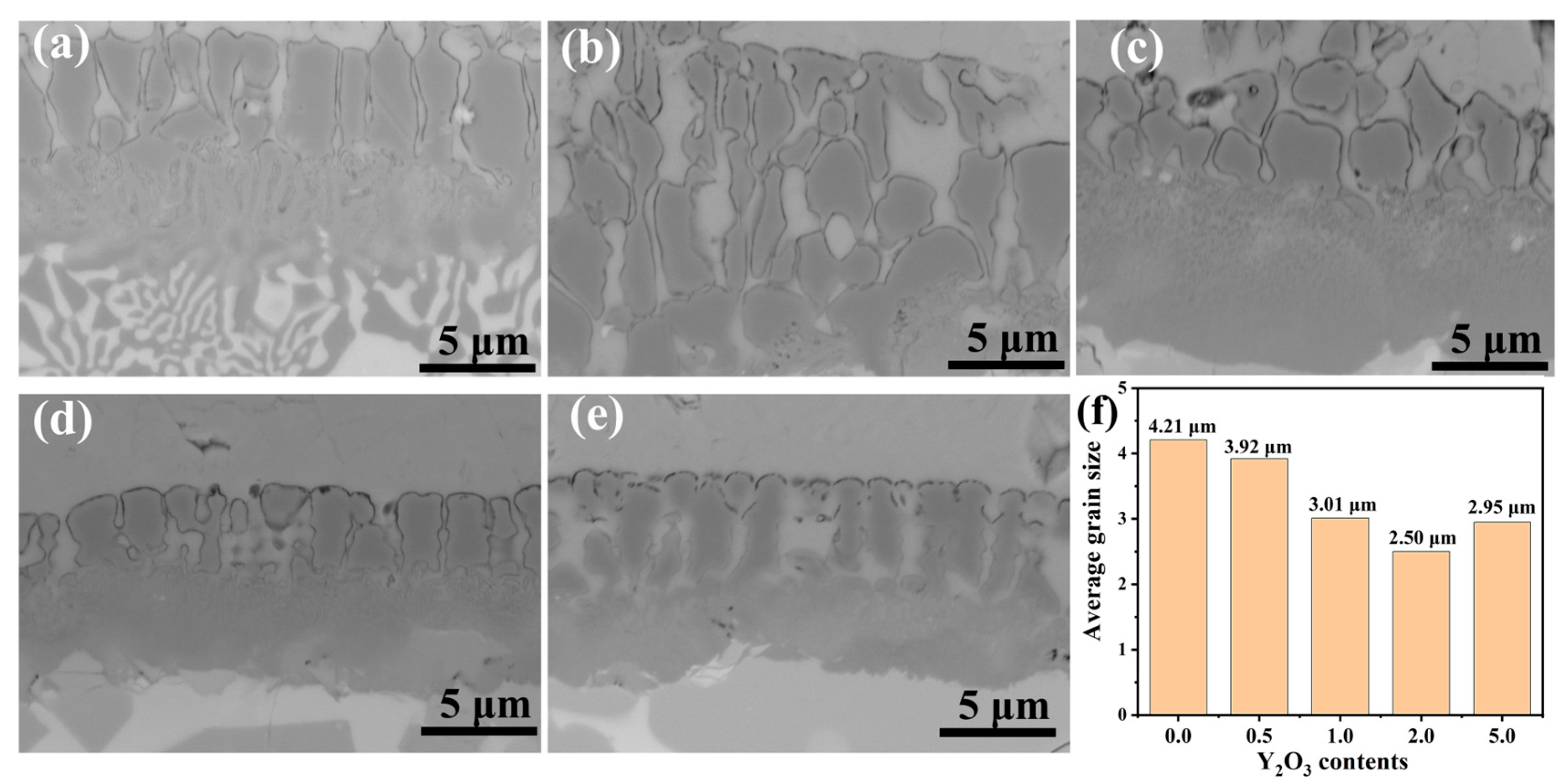
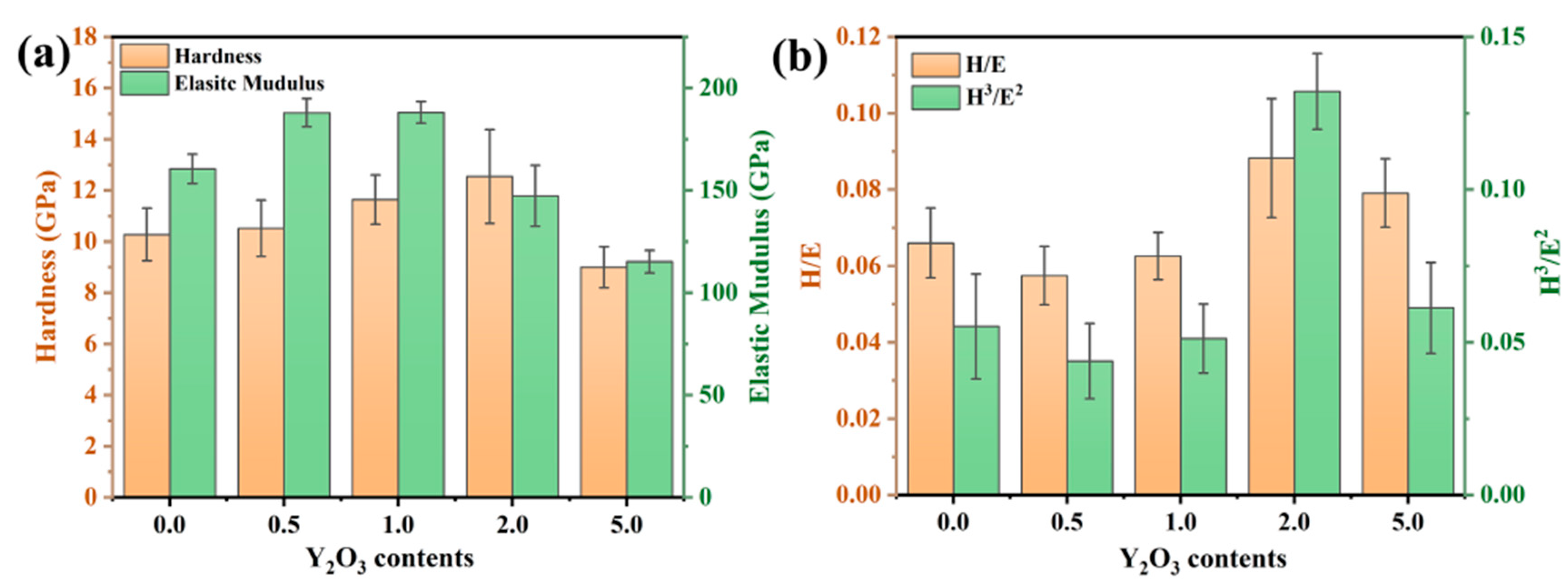
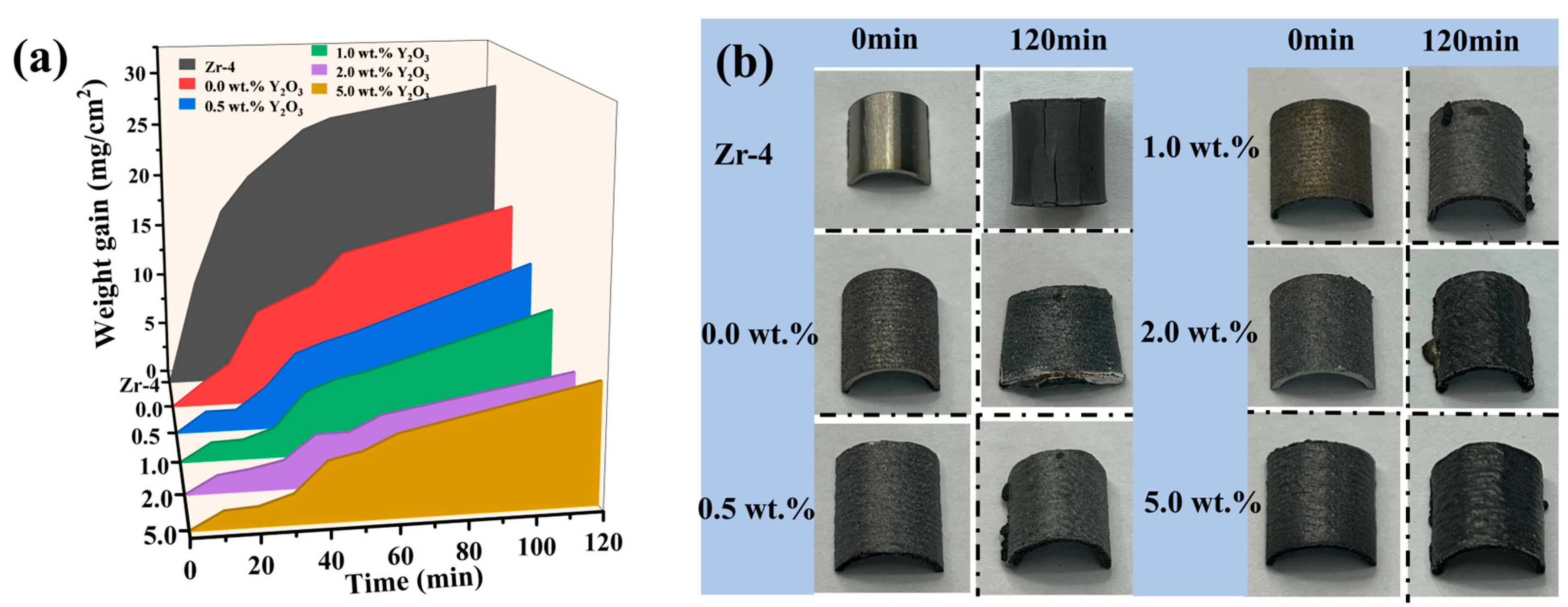
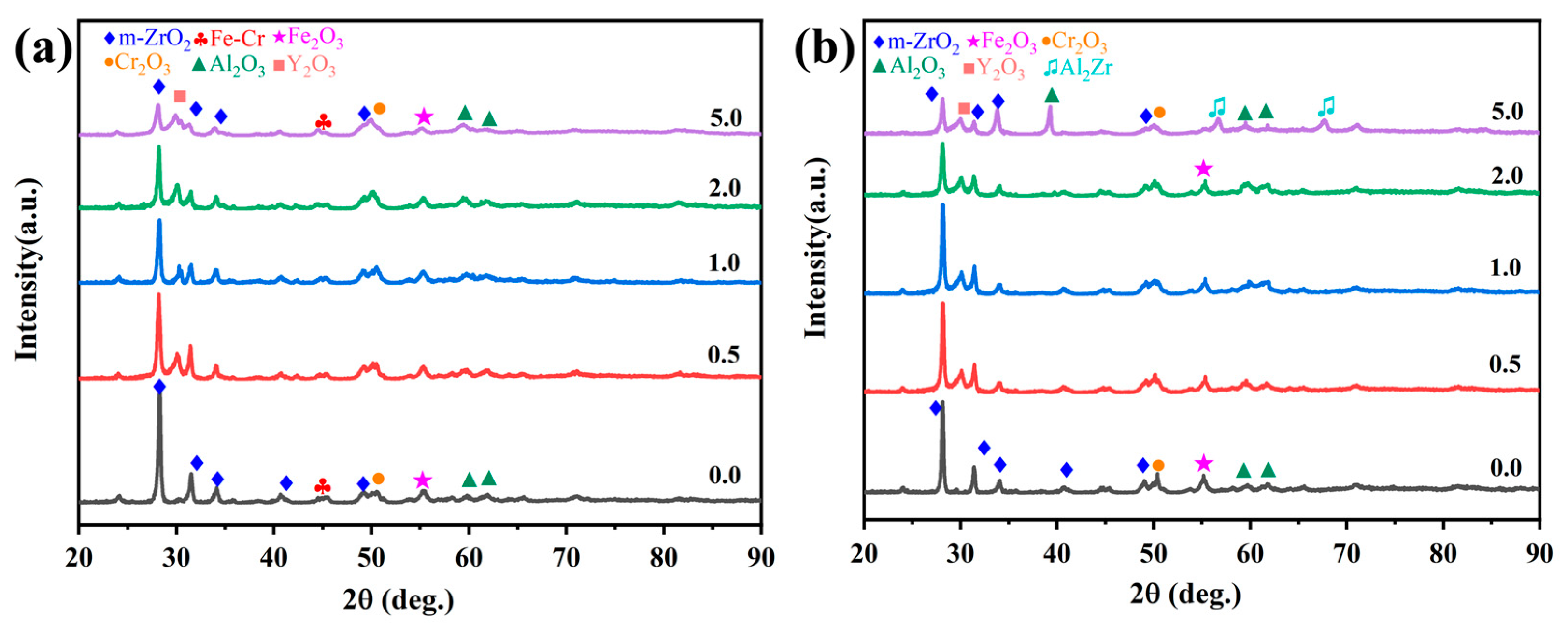
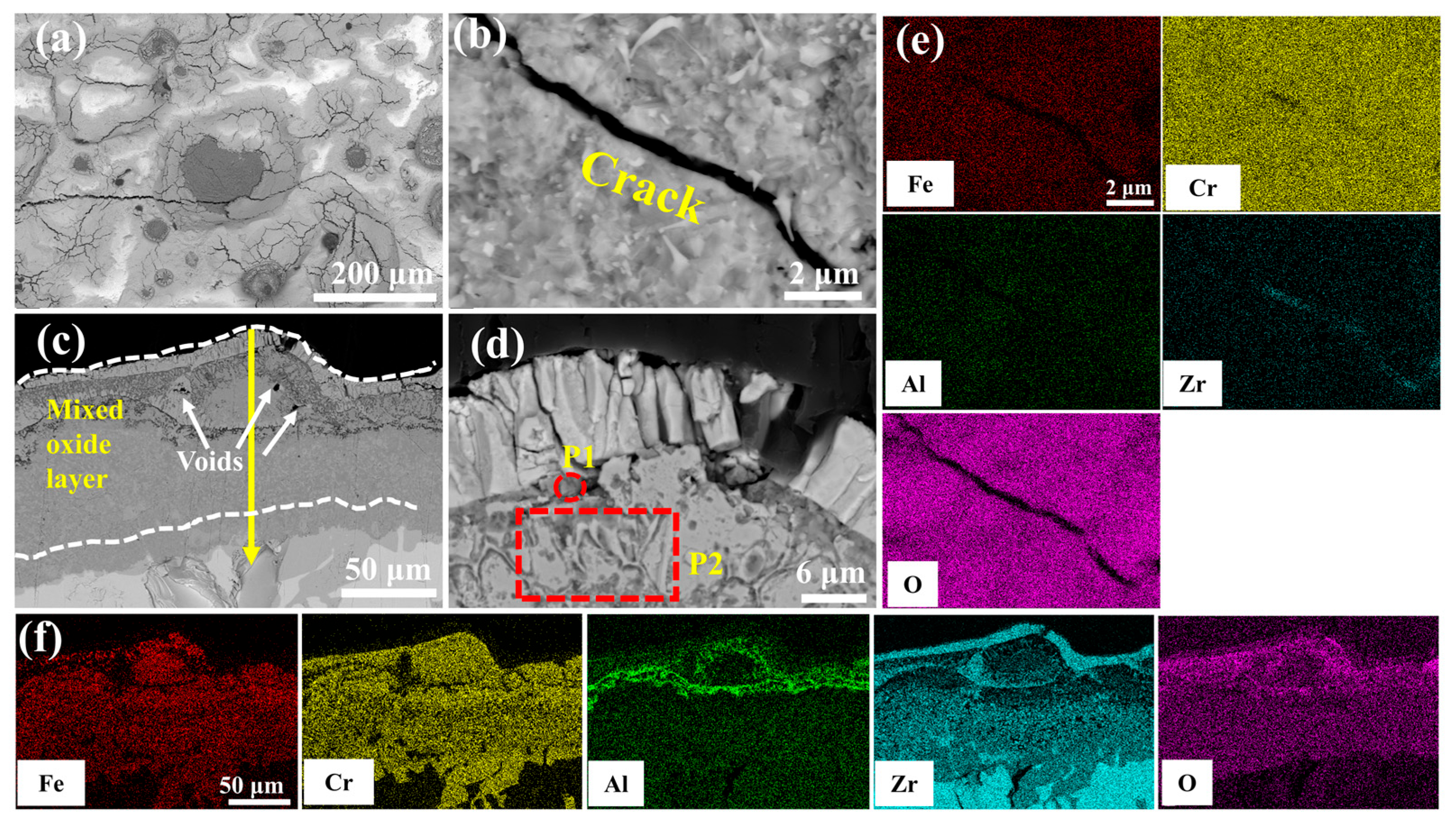
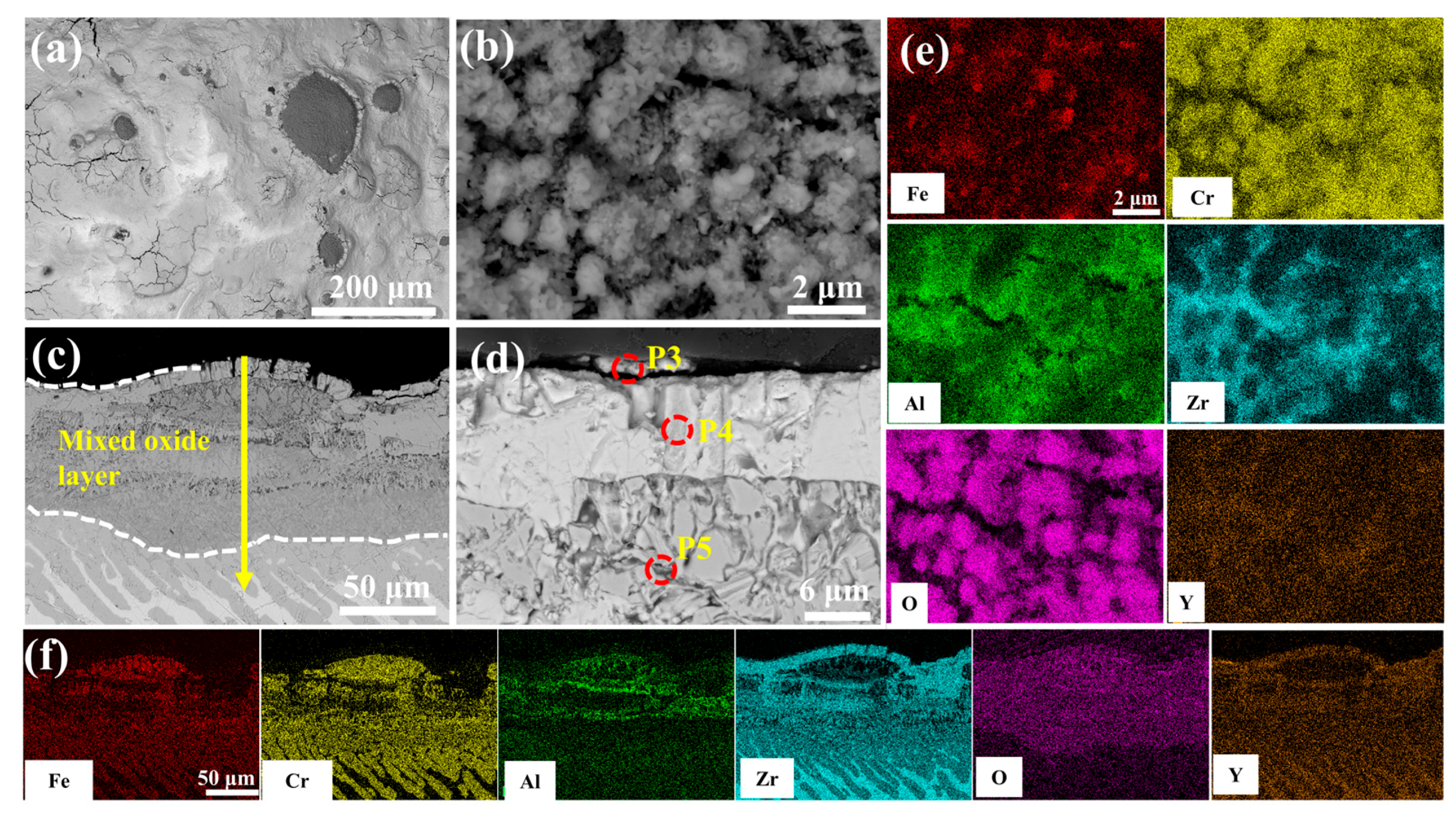
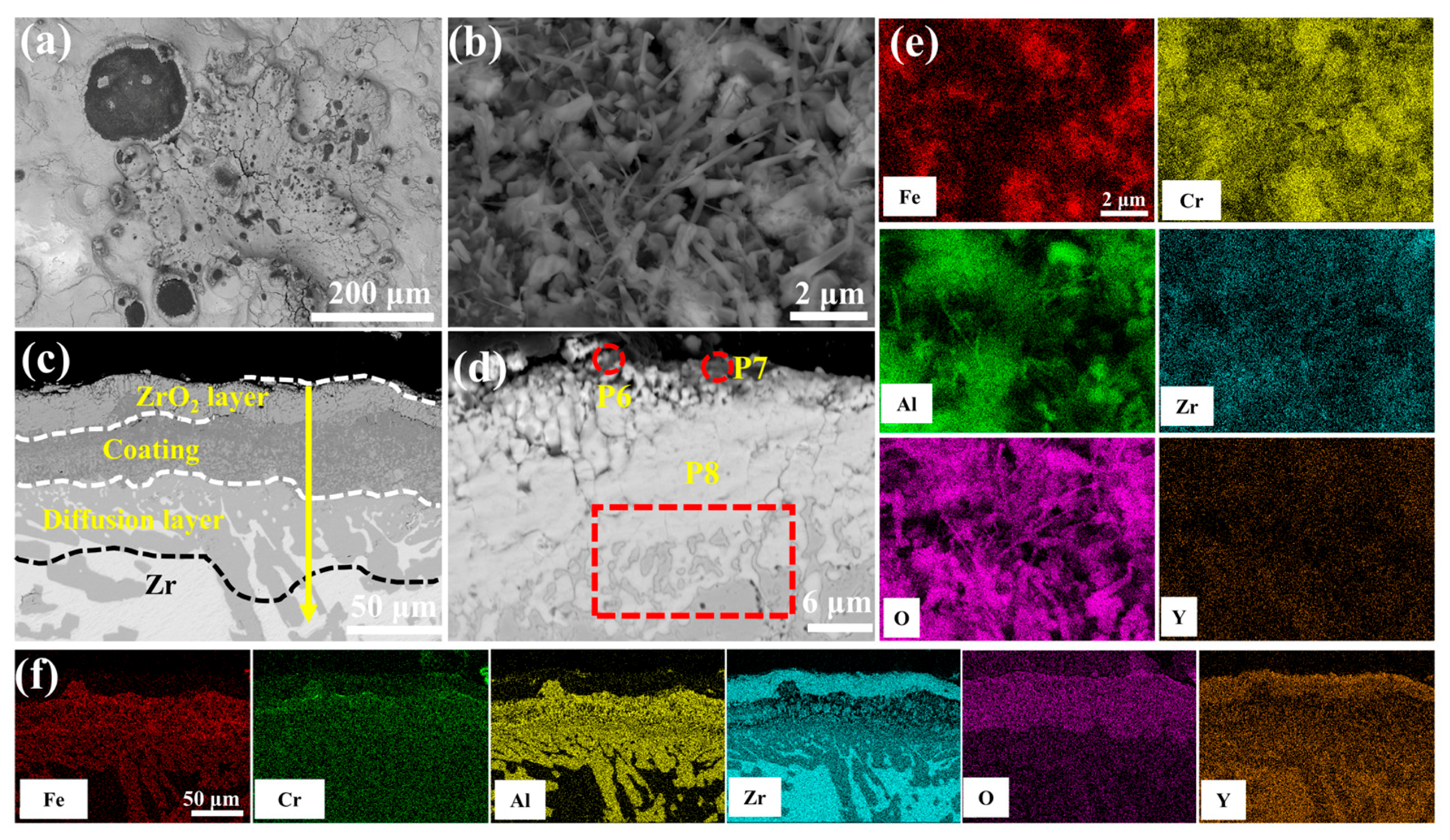

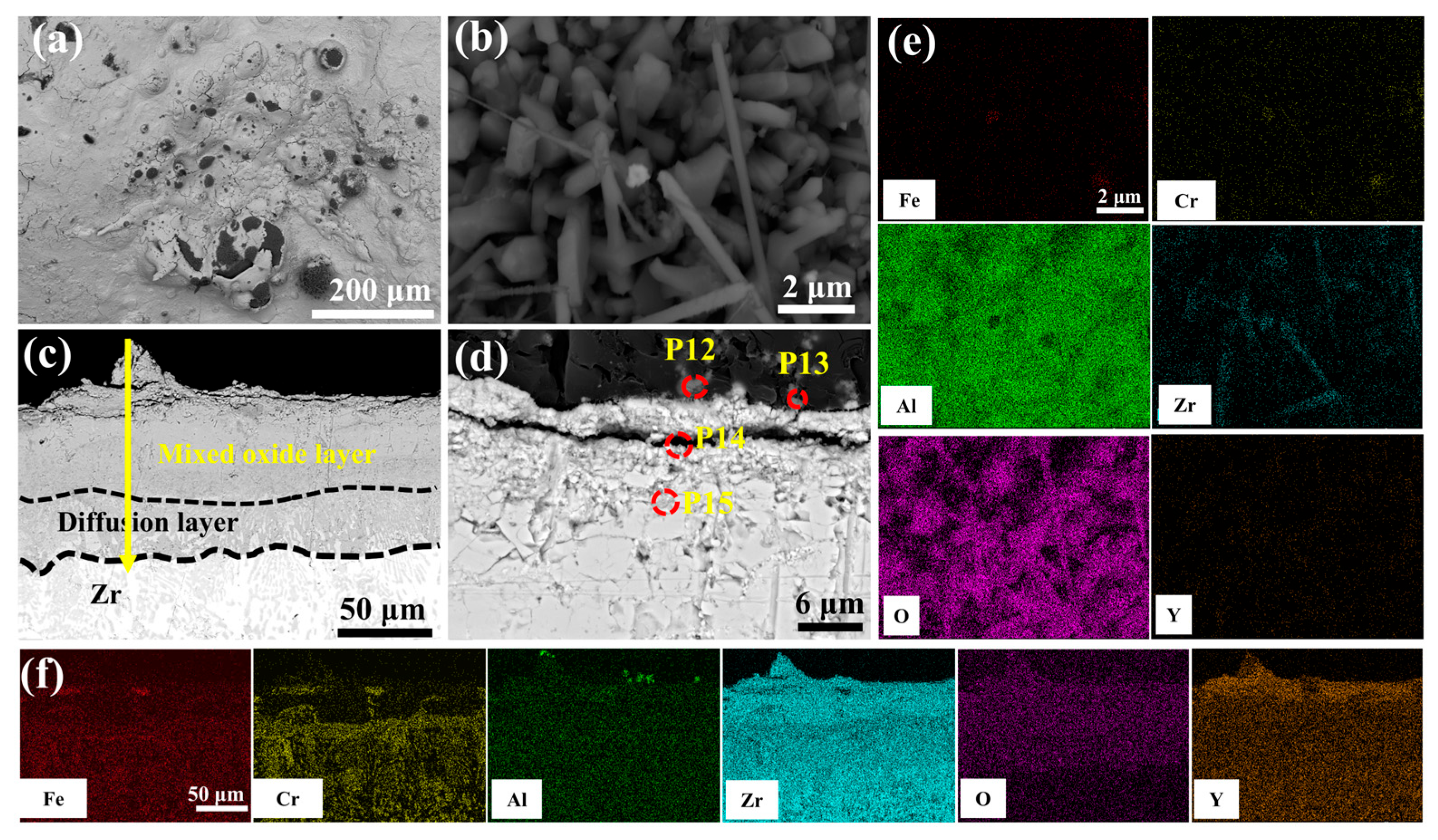
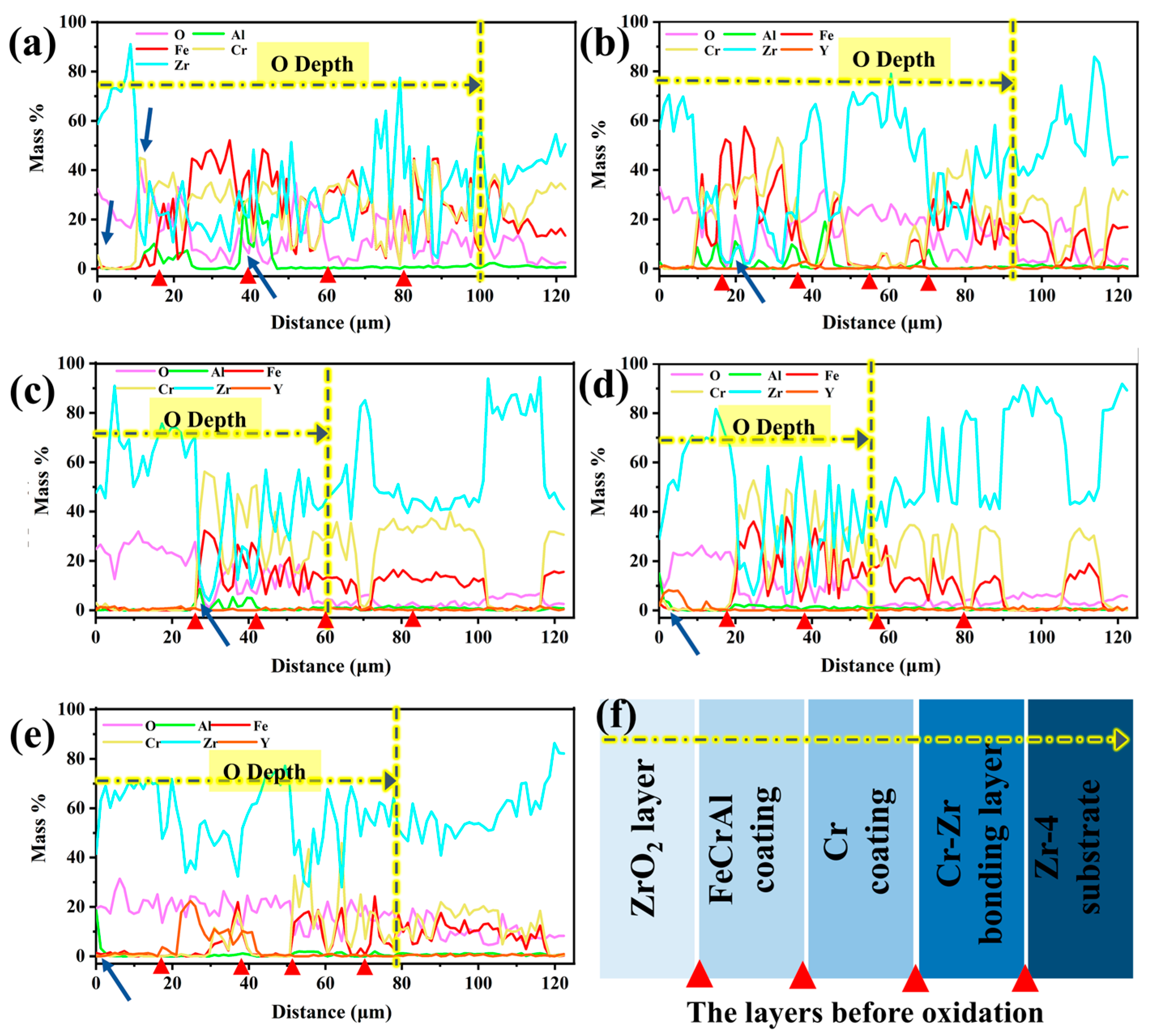
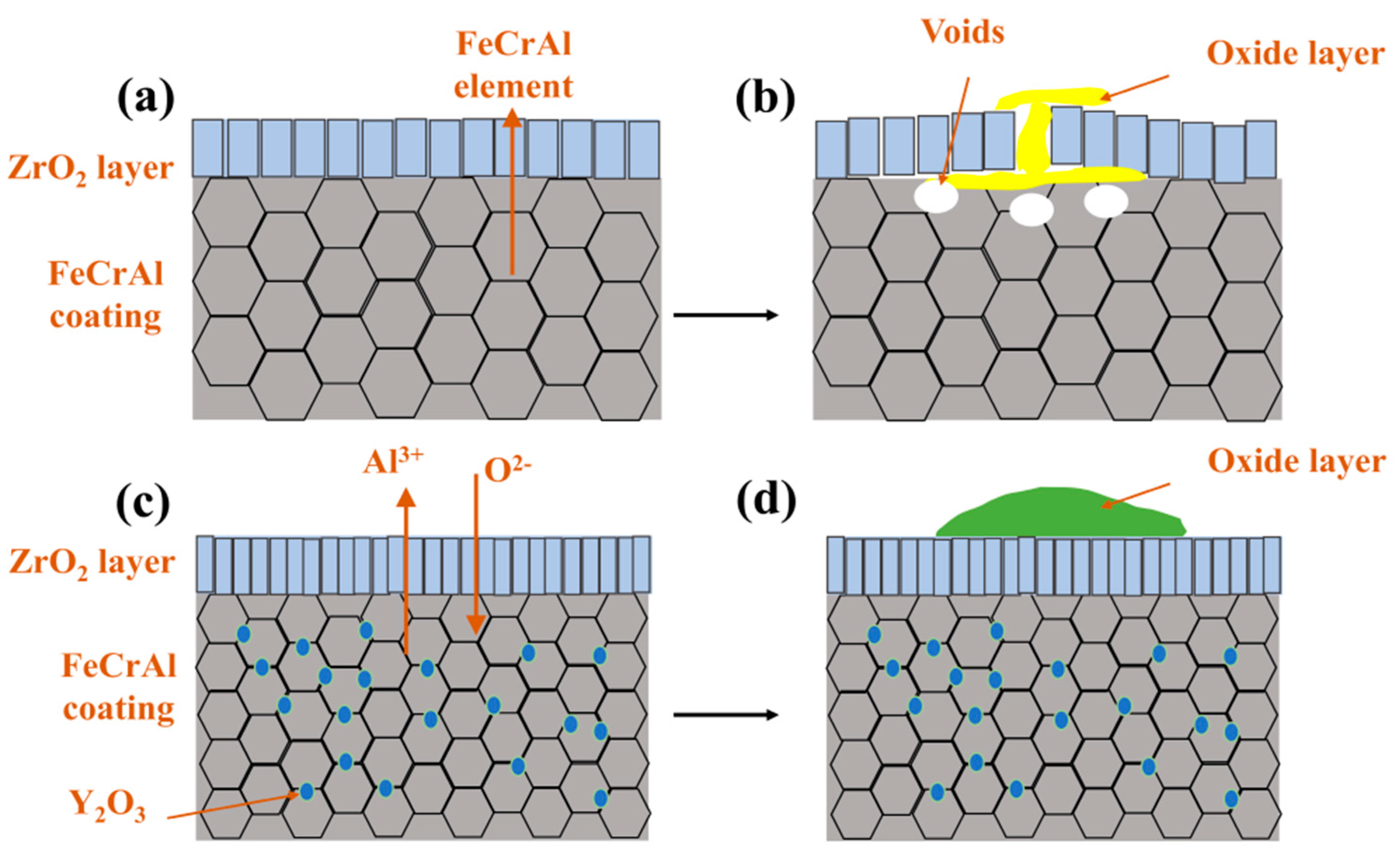
| Element | Fe | Cr | Sn | C | Zr |
|---|---|---|---|---|---|
| Content | 0.18–0.24 | 0.07–0.13 | 1.20–1.70 | 0–0.027 | Bal. |
| Sample | Composition of Coatings (wt.%) | Thickness (μm) | |||
|---|---|---|---|---|---|
| Y2O3 | Fe | Cr | Al | ||
| #A | 0.0 | 68.00 | 25.00 | 7.00 | 40 |
| #B | 0.5 | 67.66 | 24.875 | 6.965 | 39 |
| #C | 1.0 | 67.32 | 24.75 | 6.93 | 38 |
| #D | 2.0 | 66.64 | 24.5 | 6.86 | 32 |
| #E | 5.0 | 64.6 | 23.75 | 6.65 | 35 |
| Parameter | Laser Power (kW) | Cladding Speed (m/min) | Track Overlap (mm) | Powder Flow Rate (g/min) | |
|---|---|---|---|---|---|
| Value | 0.4 (Cr) | 0.45 (FeCrAl-Y2O3) | 20 | 0.6 | 3.91 |
| Composition (wt.%) | Fe | Cr | Al | Y | Zr | O |
|---|---|---|---|---|---|---|
| P1 | 1.45 | 61.61 | 4.44 | - | 9.14 | 23.36 |
| P2 | 22.84 | 32.34 | 5.58 | - | 17.49 | 21.74 |
| P3 | 1.10 | 1.47 | 0.14 | - | 86.05 | 11.24 |
| P4 | 0.63 | 1.09 | 0.06 | - | 69.67 | 28.55 |
| P5 | 14.55 | 21.27 | 9.79 | - | 30.01 | 24.37 |
| P6 | 0.73 | 2.42 | 0.49 | 12.17 | 57.45 | 26.75 |
| P7 | 1.62 | 1.45 | 4.01 | 20.37 | 43.27 | 29.29 |
| P8 | 12.81 | 20.28 | 1.72 | - | 48.60 | 16.59 |
| P9 | 8.63 | 0.71 | 3.40 | 0.27 | 61.26 | 25.73 |
| P10 | 3.23 | 1.85 | 0.10 | 2.74 | 49.75 | 42.35 |
| P11 | 0.08 | 0.21 | - | - | 47.76 | 51.95 |
| P12 | 0.26 | 0.10 | 46.46 | 1.44 | 8.33 | 43.40 |
| P13 | 0.21 | 0.47 | 31.39 | 4.30 | 15.83 | 47.81 |
| P14 | 0.35 | - | - | 10.73 | 65.15 | 23.77 |
| P15 | 0.25 | 0.06 | 0.18 | 10.45 | 65.20 | 23.86 |
Disclaimer/Publisher’s Note: The statements, opinions and data contained in all publications are solely those of the individual author(s) and contributor(s) and not of MDPI and/or the editor(s). MDPI and/or the editor(s) disclaim responsibility for any injury to people or property resulting from any ideas, methods, instructions or products referred to in the content. |
© 2025 by the authors. Licensee MDPI, Basel, Switzerland. This article is an open access article distributed under the terms and conditions of the Creative Commons Attribution (CC BY) license (https://creativecommons.org/licenses/by/4.0/).
Share and Cite
Liang, T.; Liu, J.; Zhan, C.; Peng, S.; Pu, J. Effect of Yttrium Oxide on Microstructure and Oxidation Behavior of Cr/FeCrAl Coatings Fabricated by Extreme High-Speed Laser Cladding Process: An Experimental Approach. Materials 2025, 18, 1821. https://doi.org/10.3390/ma18081821
Liang T, Liu J, Zhan C, Peng S, Pu J. Effect of Yttrium Oxide on Microstructure and Oxidation Behavior of Cr/FeCrAl Coatings Fabricated by Extreme High-Speed Laser Cladding Process: An Experimental Approach. Materials. 2025; 18(8):1821. https://doi.org/10.3390/ma18081821
Chicago/Turabian StyleLiang, Tian, Jian Liu, Chi Zhan, Shaoyuan Peng, and Jibin Pu. 2025. "Effect of Yttrium Oxide on Microstructure and Oxidation Behavior of Cr/FeCrAl Coatings Fabricated by Extreme High-Speed Laser Cladding Process: An Experimental Approach" Materials 18, no. 8: 1821. https://doi.org/10.3390/ma18081821
APA StyleLiang, T., Liu, J., Zhan, C., Peng, S., & Pu, J. (2025). Effect of Yttrium Oxide on Microstructure and Oxidation Behavior of Cr/FeCrAl Coatings Fabricated by Extreme High-Speed Laser Cladding Process: An Experimental Approach. Materials, 18(8), 1821. https://doi.org/10.3390/ma18081821






